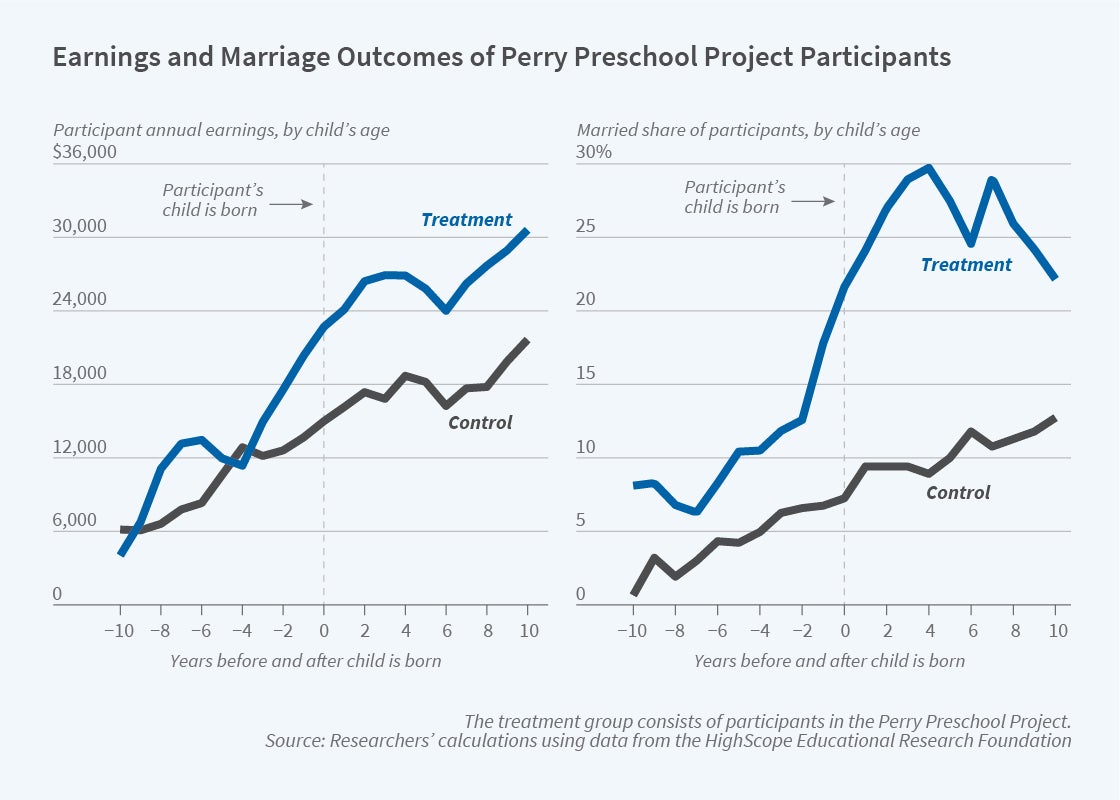Intergenerational Impacts of the Perry Preschool Project

The program had long-lasting effects on cognition, and first-generation treatment group members also have more stable home lives and higher incomes in their child-rearing years.
Using newly collected late midlife measures of skills and life cycle panel data from surveys and administrative criminal records, Jorge Luis García, James J. Heckman, and Victor Ronda explore intergenerational impacts of the Perry Preschool Project (PPP), an early childhood education program designed to promote social mobility among disadvantaged African American children. Their study, The Lasting Effects of Early Childhood Education on Promoting the Skills and Social Mobility of Disadvantaged African Americans (NBER Working Paper 29057), finds that the program had multiple positive impacts, several of which affect the children of PPP participants.
Launched in Ypsilanti, Michigan in 1962, the PPP was intended to foster development of cognitive and socioemotional skills and promote social mobility. Eligibility criteria based on IQ scores and socioeconomic status were used to create a pool of 123 disadvantaged African American children who were randomized into treatment and control groups. Treatment group children received two years of two-and-a-half-hour preschool sessions on weekdays starting at age three, as well as weekly teacher home visits during the treatment period. Control group children received no interventions. The researchers analyzed the effects of the PPP because it continues to influence the design of current and proposed early childhood education programs. At least 30 percent of current Head Start programs are based on it, and more than 10 percent of African American children born in the 2010s would be eligible for it.
Using new data on the original PPP participants, and on their children, many of whom are now in their mid-20s, the researchers find long-lasting beneficial program effects. They find positive effects on cognition for participants through age 54, contradicting claims of fadeout that have dominated popular discussions of early childhood programs. First-generation treatment group members also have more stable home lives in terms of marriage and divorce, as well as higher incomes in their child-rearing years.
These improved outcomes across the life cycle have translated into better family environments for the second generation, the children of the PPP participants, and these improved home environments are the source of the PPP’s intergenerational benefits. Children of the first generation of treatment participants were more likely than children of the first generation of control participants to grow up in stable two-parent households. Their parents have higher average earnings, less engagement with the criminal justice system, and better executive functioning (cognition), socioemotional skills, and health. The children of treatment group members are also less likely to be enrolled in special education, and they are 17 percentage points less likely to have been suspended from school during K-12 education than the children of control group members. They are more likely to be high school graduates and much less likely to engage in crime. They are also 11 percentage points more likely to be in good health through young adulthood, 26 percentage points more likely to be employed, and 8 percentage points less likely to be divorced.
The researchers find important differences in the PPP’s impact by gender. The male children of the male treatment group members receive the greatest benefits, consistent with literature on the adverse effects of disadvantaged environments on boys. For example, children of male treated participants are 18 percentage points less likely to have been arrested through young adulthood compared to children of male control participants.
— Lauri Scherer


